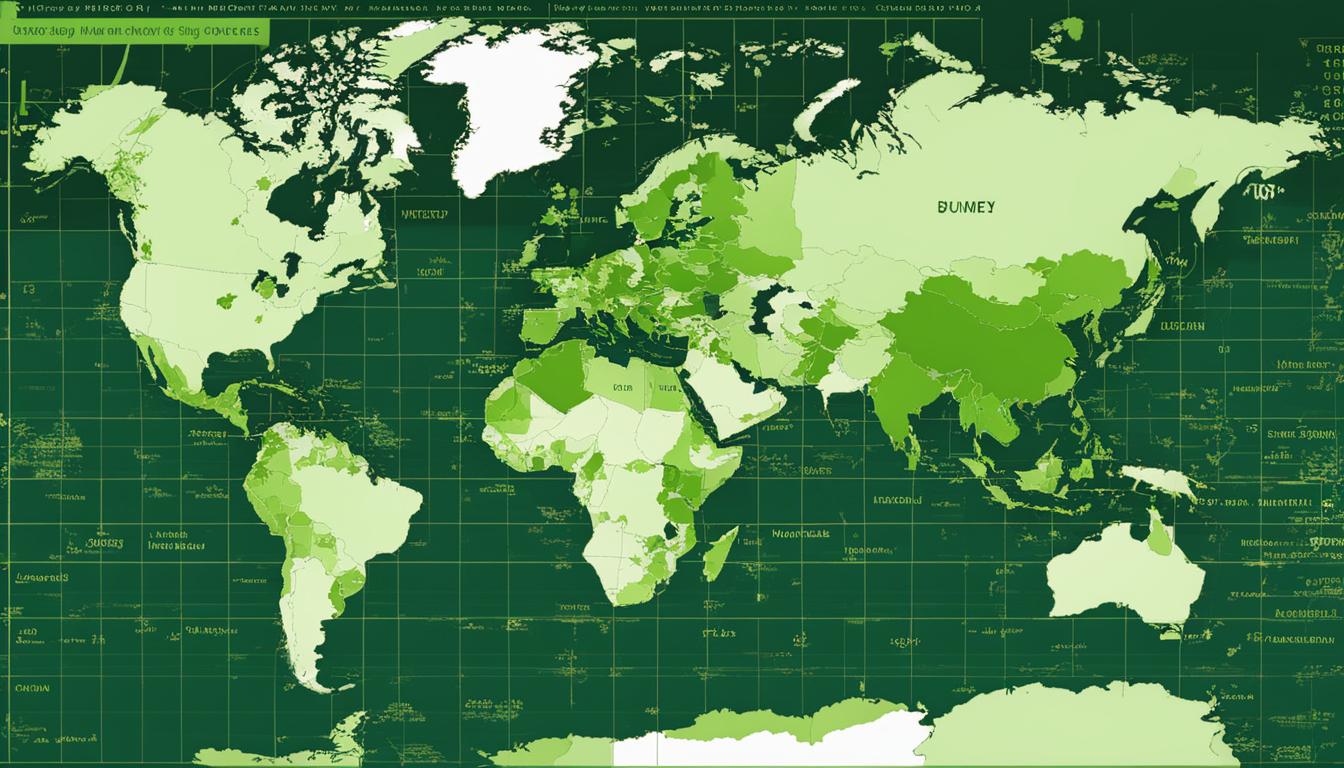The landscape of the foreign exchange market is a dynamic and expansive field where the value of money is in constant flux. Within this arena, currency pairs engage in a dance of supply and demand, driven by international trade, economic news, and investor sentiment. While numerous currencies vie for attention in currency trading, a select few garner the lion’s share of transactions, setting the pace for liquidity and opportunity.
At the pinnacle of this financial ecosystem is the US dollar (USD), which towers above its counterparts in terms of daily traded volume and influence. Underpinned by the economic might of the United States and managed by the Federal Reserve, the USD’s prevalence in global financial reserves is an attestment to its unyielding dominance in the forex market. It becomes indispensable to not only understand but also to monitor the movements of these most traded currencies to harness the formidable tides of the foreign exchange market.
The Dominance of the US Dollar in Currency Exchange
The meteoric dominance of the US dollar in the global market is not without reason. Renowned as a global currency and reserve currency, the USD’s value tells a story of strong economic performance, strategic importance in pricing critical commodities, and a substantial presence in worldwide currency reserves. In essence, the dollar is much more than a unit of exchange; it’s a barometer of economic health and a pivotal player in international finance.
Why the USD Holds the Pinnacle Position
The US dollar’s reign at the summit of currency exchange is underpinned by a sophisticated blend of historical precedence, widespread trust, and economic might. Here’s a snapshot of its supremacy:
- Recognized as the default transaction medium for global trade.
- Holds unparalleled liquidity, contributing to its preference in the forex markets.
- Serves as the primary currency in which major commodities like oil and gold are priced, nurturing a perpetual demand.
This dominance is not just ascribed by convention but reinforced by the sheer scale of the American economy and its financial institutions. Countries across the globe hold the dollar as a reserve to manage exchange rates and to back their own currencies’ stability.
Impact of Economic Indicators on USD Value
Economic indicators are vital signs that gauge the US dollar’s health. They range from job reports and consumer spending data to trade balances and interest rate decisions by the Federal Reserve. Positive data generally boosts the dollar’s value, demonstrating an invigorating economic landscape.
Certain indicators hold more weight than others:
- Gross Domestic Product (GDP)
- Employment data
- Inflation reports
- Retail sales figures
These indicators not only affect policy decisions but also provide investors with cues to assess America’s economic performance, consequently influencing the USD value relative to other currencies.
Key USD Currency Pairs to Watch
Within the bustling corridors of currency exchange, a spotlight shines on some standout USD currency pairs. Their movements capture investors’ attention as they reflect broader economic narratives and trade relations.
| Currency Pair | Relevance | Impact Factors |
|---|---|---|
| EUR/USD | Most traded currency pair | Eurozone economic indicators and ECB policies |
| USD/JPY | Gauges investor risk appetite | Japan’s economic indicators and Bank of Japan policies |
| GBP/USD | Reflects UK-US trade relations | British economic data and Bank of England policies |
| USD/CNY | Represents US-China economic health | Trade policies, Chinese economic performance |
| USD/CAD | Linked with commodity pricing especially oil | Commodity price fluctuations, Canadian economic indicators |
These pairs serve as a crucial barometer for the US dollar’s performance against its major counterparties and are essential in constructing a diversified foreign exchange portfolio.
The Euro’s Command in the Foreign Exchange Market
The eurozone’s consolidated financial policies and economic indicators bear substantial implications for the valuation of the Euro. Spearheaded by the European Central Bank, the Euro serves as the primary currency for one of the largest currency areas in the world, positioning it as an influential player in the realm of currency exchange and as a vital reserve currency.
The Eurozone’s Economy and EUR Valuation
The economy of the eurozone is a tapestry rich with diverse fiscal activities and policies. These internal mechanisms, in harmony with global economic trends, forge the strength and stability of the Euro. The European Central Bank (ECB) effectively steers the economic helm, utilizing monetary policy to adapt to changing financial landscapes, impacting the value of EUR/USD—the most traded currency pair involving the Euro.
Political Events and the Euro’s Performance
Political stability and policy decisions within the Euro member countries can either bolster investor confidence or provoke volatility in currency exchange rates. Elections, legislative reforms, and international treaties are examples of political events that could sway the Euro’s standing on the forex market stage.
Most Liquid EUR Currency Pairs
Among the myriad of currency pairs traded globally, the Euro is a common denominator in several of the most liquid pairs. Thanks to substantial trade volumes and tight spreads, the EUR/USD stands at the forefront, trailed by other major pairs such as EUR/JPY and EUR/GBP. Here’s an overview of the most liquid EUR currency pairs and their characteristics:
| Currency Pair | Average Daily Volume | Volatility | Spread |
|---|---|---|---|
| EUR/USD | $1.1 trillion | Medium | Low |
| EUR/JPY | $378 billion | High | Low to Medium |
| EUR/GBP | $245 billion | Medium | Low |
The Role of the Japanese Yen as the 3rd Most Traded Currency
The Japanese yen, upheld by the economic prowess of Japan, is a significant player in the foreign exchange market. With an average daily trading volume reflecting its solid position, the yen is not only Japan’s official currency but also a favored investment and funding currency across the globe. Characterized by its liquidity and relatively low interest rates, it serves as a benchmark for Asia’s economic health. The Bank of Japan strategically maneuvers monetary policies to influence the yen’s value, sometimes intervening in the forex market to balance inflation and growth.
In assessing the yen’s impact, one cannot overlook the critical role of the manufacturing sector which showcases Japan’s industrial efficiency and innovation. This powerhouse sector, encompassing the production of world-renowned vehicles, state-of-the-art electronics, and cutting-edge textiles, heavily contributes to the currency’s valuation. Economic indicators stemming from manufacturing outputs, trade balances, and industrial productivity reports are influential metrics for traders and analysts scrutinizing the yen.
| Indicator | Description | Impact on Japanese Yen |
|---|---|---|
| GDP Growth Rate | Measures the rate of economic growth in Japan | Positive growth can strengthen the yen |
| Bank of Japan’s Interest Rate Decision | Policy rate set by the BoJ influencing lending rates | High rates may result in a more valuable yen |
| Manufacturing PMI | An index of the prevailing direction of economic trends in manufacturing | Above 50 signals industry expansion, potentially boosting the yen’s desirability |
| Trade Balance | A record of Japan’s import vs. export values | A trade surplus can signify a strong yen as demand for Japanese goods requires yen conversion |
| Unemployment Rate | Indicates the percentage of the total workforce that is unemployed and actively seeking employment | Lower unemployment rates can hint at a robust economy and fortify the yen |
Japan’s macroeconomic landscape provides a fascinating backdrop to the yen’s journey in the foreign exchange market. Investors and traders alike monitor these economic indicators to predict the fluctuations and strength of the Japanese yen and to strategize their positions in the dynamic currency exchange setting.
Trading Dynamics of the British Pound Sterling
With a linchpin position in the forex market, the British pound sterling is a true embodiment of historic prestige and modern financial fluidity. The currency holds the title as the world’s fourth most traded currency, a testament to its standing and influence in currency trading. Governed and issued by the Bank of England, the sterling navigates through the tumultuous waves of the foreign exchange market, exhibiting a daily trade volume nearing the colossal sum of USD $422 billion. This immense trading activity underscores the pound’s vital role in global finance and its 4.5% stake in the world’s currency reserves.
When assessing currency performance, the pair GBP/USD frequently becomes the focus of discussions among traders and financial analysts. Not only does this pair reflect the intertwined economic relationships between two of the most significant economies on the planet, but it also serves as a barometer for currency volatility. External factors ranging from political climates to economic news releases have the power to sway the value of the pound, often resulting in sharp price movements that underscore the need for astute risk management in currency trading.
Understanding the nuances of currency trading with the British pound requires more than just knowledge of exchange rate mechanisms; it demands keen insight into the cultural, political, and economic events that shape the UK’s financial narrative. For investors and traders who endeavor to navigate the shores of the forex market, the British pound sterling represents not just a currency, but a voyage through the rich tapestry of UK’s history and its impact on the dynamics of global trade and finance.
FAQ
The most traded currencies in the forex market are the US dollar (USD), the Euro (EUR), the Japanese yen (JPY), and the British pound sterling (GBP). These major currencies dominate due to their stability, economic backing, and high volume of daily transactions.
The Japanese yen is the 3rd most traded currency due to Japan’s status as a major global economic power, particularly in the manufacturing and export sectors. Its safe-haven status during times of economic uncertainty also adds to its trading volume.






